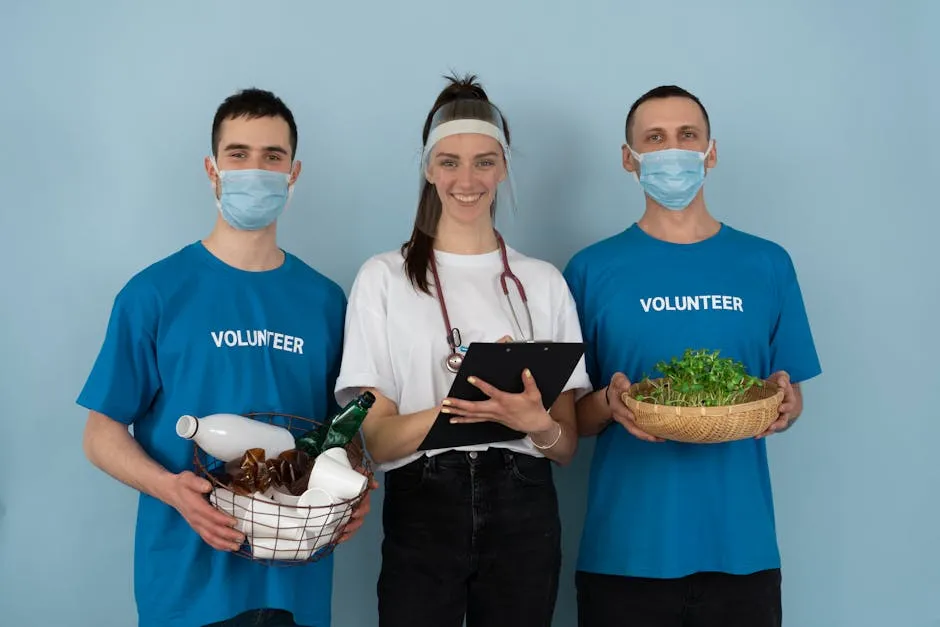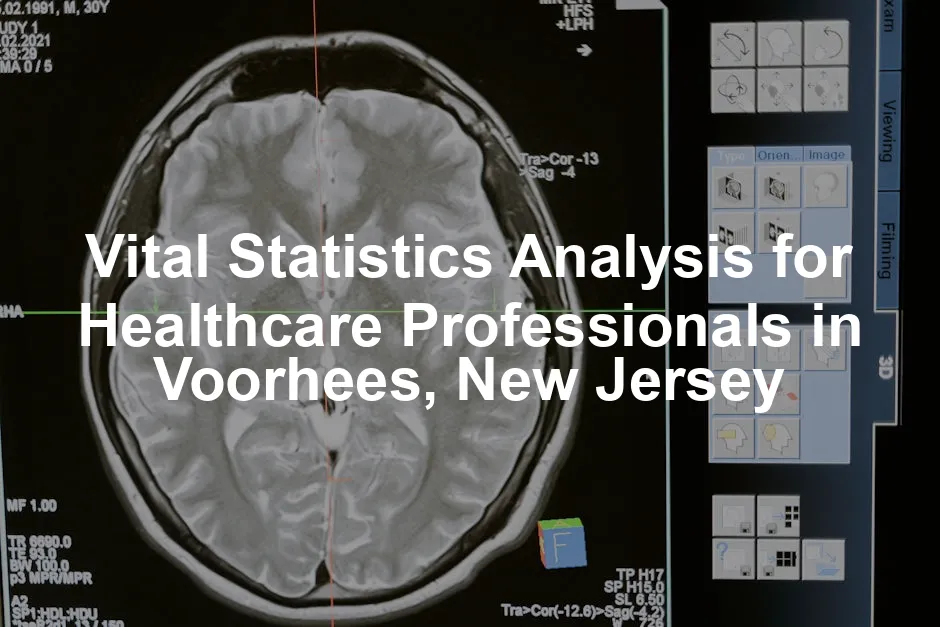Introduction
In the bustling realm of healthcare, vital statistics are more than mere figures; they tell stories of lives, health trends, and community needs. For healthcare professionals in Voorhees, New Jersey, these statistics serve as invaluable tools. They help shape public health policies, guide patient care, and enhance community wellness. Think of vital statistics as a healthcare GPS; they provide the directions needed to navigate the complex landscape of health challenges and opportunities.
So, what exactly are vital statistics? They encompass the records of births, deaths, marriages, and civil unions. In Voorhees, these records are meticulously maintained by the Voorhees Township Vital Statistics Office. This office plays a crucial role in processing these documents and ensuring their accuracy. Understanding how to interpret and utilize this data can empower healthcare professionals to make informed decisions.
But it’s not just about the numbers! The insights gleaned from vital statistics can spark innovative community health initiatives and improve overall patient outcomes. Imagine a doctor in Voorhees using data to identify a rise in chronic illnesses. Armed with this knowledge, they can advocate for preventive programs tailored to local needs.
As we embark on this exploration of vital statistics analysis, prepare to uncover the wealth of information that these records hold. Grab your favorite caffeinated beverage, and let’s unlock the insights behind the numbers! Together, we’ll discover how vital statistics can enhance your practice and contribute to a healthier Voorhees community.

Summary of Key Points
This article will explore the essential aspects of vital statistics analysis for healthcare professionals in Voorhees, NJ. Key points include:
- Understanding Vital Statistics: Definitions, importance, and how they are collected and maintained by local offices.
- Local Regulations and Procedures: A detailed look at the Voorhees Township Vital Statistics Office’s role in processing vital records, including birth, death, marriage, and civil union certificates.
- Data Utilization: How healthcare professionals can leverage vital statistics to inform clinical practices, community health initiatives, and policy development.
- Case Studies: Real-world examples of how statistical analysis has led to improvements in healthcare outcomes in Voorhees.
- Community Resources: Information on local programs that utilize vital statistics data for public health initiatives, such as Virtua Health’s community programs.
- Future Trends: Emerging methodologies and technologies in vital statistics analysis and their potential impact on healthcare in Voorhees.
Stay tuned as we dissect these topics and provide you with actionable insights that can enhance your practice and contribute to the overall health of the Voorhees community.

The Importance of Vital Statistics Analysis
What Are Vital Statistics?
Vital statistics are the backbone of public health data. They capture key events in the human lifecycle, including births, deaths, marriages, and civil unions. These records provide a snapshot of population trends and health outcomes in a community.
Birth statistics reveal the number of new lives entering the world. They offer insights into maternal health and infant care. When healthcare professionals analyze these statistics, they can identify trends, such as increases in certain birth complications. This information helps shape prenatal care programs. To enhance these programs, consider using Baby’s First Year: A Month-by-Month Guide to Your Baby’s Development. This book is a treasure trove of information for new parents, helping them navigate the early stages of life.
Death statistics, on the other hand, highlight mortality rates and causes of death. Understanding these figures can guide healthcare services in addressing prevalent health issues. For instance, if the data shows a surge in heart disease-related deaths, local hospitals can tailor their programs to focus on heart health initiatives. To monitor your heart health effectively, consider investing in a Home Blood Pressure Monitor. Keeping track of your blood pressure can be a game-changer in managing your health.
Marriages and civil unions are equally significant. These statistics can indicate community stability and social dynamics. They may also reflect the need for family health services, such as counseling or parenting classes.
In summary, vital statistics are essential in healthcare planning. They help professionals make informed decisions, allocate resources effectively, and implement programs that address community needs. Accurate data is crucial for improving public health outcomes.

Role of Vital Statistics in Healthcare
Vital statistics play a vital role in informing healthcare policy and resource allocation. They provide a wealth of information that healthcare professionals can leverage to enhance patient care. By understanding population trends, providers can anticipate healthcare demands.
For example, if vital statistics show a rising elderly population, healthcare facilities can prepare for increased demand for geriatric services. This proactive approach ensures that resources are allocated where they are most needed. If you’re looking to track your fitness and health trends, a Fitbit Charge 5 can be your best friend! It tracks your activity levels, heart rate, and more, giving you insights into your health journey.
Accurate data collection and reporting are paramount. Without reliable vital statistics, healthcare professionals may base decisions on flawed information. This could lead to misallocation of resources or ineffective health interventions.
Moreover, vital statistics contribute to epidemiological studies. They help identify health trends and risk factors within a population. This information is crucial for developing targeted health campaigns and preventive measures.
In Voorhees, New Jersey, healthcare professionals can utilize local vital statistics to inform their practices. By analyzing these records, they can better understand community health needs and advocate for necessary changes. This data-driven approach leads to improved health outcomes for residents.
In conclusion, the importance of vital statistics analysis cannot be overstated. They serve as a compass, guiding healthcare professionals in their mission to enhance public health. By utilizing accurate and timely data, providers can make informed decisions that ultimately lead to healthier communities.

Understanding the Local Vital Statistics Office
Structure and Function
The Voorhees Township Vital Statistics Office is the local hub for vital records management. This office handles the registration of all significant life events, including births, deaths, marriages, and civil unions. They play a critical role in maintaining these records accurately.
Every year, the office processes thousands of vital records. This includes more than 6,000 birth certificates alone! The team is dedicated to ensuring that each record is meticulously filed and readily accessible. This commitment helps uphold the integrity of public health data in Voorhees.
In addition to record-keeping, the office is responsible for issuing certified copies of vital records. Individuals needing these documents can rely on the office for assistance. The staff is trained to guide residents through the application process, making it as seamless as possible.

Procedures for Obtaining Vital Records
Obtaining vital records in Voorhees is a straightforward process. First, individuals must complete an application form for the specific record they need. These forms can be downloaded online or obtained directly from the Vital Statistics Office.
For a birth certificate, applicants must provide valid identification. This includes a driver’s license or two pieces of mail dated within the last 90 days. The fee for a certified birth certificate is $25. If you need it urgently, same-day service is often available at Town Hall.
Marriage licenses require a bit more preparation. Couples must apply in person and provide identification, proof of residency, and social security numbers. There’s a $28 fee, and a 72-hour waiting period applies before the license is issued.
Death certificates are also accessible, but applicants need to demonstrate their relationship to the deceased. The first copy costs $25, while additional copies are available for just $2 each.
For convenience, the Vital Statistics Office offers online ordering through an approved service. This option allows residents to request certified copies of vital records using a credit card, although additional fees may apply.
In summary, the Voorhees Township Vital Statistics Office is vital for managing local records. By understanding the procedures for obtaining vital records, healthcare professionals and residents can ensure they have the necessary documentation for their needs. This efficient process supports public health initiatives and fosters community well-being.

Analyzing Vital Statistics Data
Methods of Analysis
When it comes to analyzing vital statistics data, healthcare professionals often employ two main approaches: quantitative and qualitative analysis.
Quantitative analysis focuses on numerical data, allowing for statistical evaluation. This method helps in identifying trends and patterns, such as changes in birth and death rates over the years. For instance, a spike in births during a specific period may indicate a community trend worth investigating. To aid in this analysis, consider utilizing resources like The Data Warehouse Toolkit: The Definitive Guide to Dimensional Modeling. This guide is essential for anyone looking to dive deep into data analysis.
On the other hand, qualitative analysis digs deeper into the stories behind the numbers. It involves examining non-numerical data, such as personal narratives or community feedback. This approach can uncover why certain trends exist, providing a fuller picture of health dynamics.
Common statistical methods used in vital statistics analysis include regression analysis, which helps identify relationships between variables. For example, healthcare professionals may use regression to assess how socioeconomic factors influence health outcomes in Voorhees. Another method is time series analysis, which tracks changes over time, highlighting fluctuations in birth and death rates.
By combining both quantitative and qualitative analyses, healthcare professionals can develop robust strategies to address community health needs effectively. This dual approach ensures that the data is not just numbers but a reflection of the community’s health landscape.

Case Studies
Local healthcare initiatives have successfully harnessed vital statistics data to improve health outcomes in Voorhees. For example, the Virtua Health system utilized birth data to launch targeted prenatal programs. By identifying an uptick in premature births, they created specialized care pathways for at-risk mothers. This not only reduced complications but also strengthened community trust in local health services.
Another noteworthy initiative involved analyzing death rates related to chronic diseases. The data revealed alarming trends in heart disease and diabetes in specific demographics. In response, healthcare providers developed outreach programs focused on education and prevention. These initiatives included free health screenings and workshops on nutrition and exercise. As a result, the community saw a notable decrease in hospitalizations related to these conditions. To further enhance your nutrition, consider the Nutrition Labels Book: The Complete Guide to Food Labels. This book helps you make informed dietary choices!
Recent trends in birth and death rates in Voorhees also provide food for thought. Birth rates have shown slight fluctuations, with some years experiencing a dip, followed by a surge. This fluctuation can reflect broader societal trends, like economic changes or shifts in family planning practices.
On the death rate front, an analysis revealed an increasing prevalence of lifestyle-related ailments. This insight prompted healthcare professionals to advocate for community wellness programs. They collaborated with local gyms and health food stores to create initiatives promoting healthier lifestyles, resulting in a more health-conscious community. If you’re looking to enhance your fitness journey, a Fitness Tracker by Garmin might be just what you need!
By leveraging vital statistics data, Voorhees healthcare professionals continue to drive positive change. These case studies exemplify the power of data-informed decision-making in enhancing community health.

Utilizing Vital Statistics for Public Health
Community Health Initiatives
Vital statistics not only provide a snapshot of community health but also serve as a foundation for impactful public health initiatives. Organizations like Virtua Health have effectively used this data to guide their programs and services in Voorhees.
One standout program is the mobile farmers market, which delivers fresh produce to underserved areas. By analyzing data on food insecurity and health outcomes, Virtua identified neighborhoods in need. The initiative not only promotes better nutrition but also fosters community engagement. Residents can purchase healthy foods at reduced prices, making wellness more accessible. If you’re looking for easy meal prep solutions, check out Meal Prep Containers by Prep Naturals. These containers make healthy eating a breeze!
Local organizations have also launched health education classes focused on critical topics like chronic disease management and preventive care. These classes draw on vital statistics to tailor content to community needs. For instance, if data shows a rise in diabetes, workshops on managing this condition become a priority.
Moreover, Virtua’s free cancer screening programs illustrate a proactive approach to public health. Utilizing vital statistics, the organization targets populations at higher risk, ensuring they receive necessary screenings. This effort aligns with their mission to reduce health disparities in the community.
The integration of vital statistics into community health initiatives showcases a commitment to improving overall well-being. By using data-driven strategies, local organizations not only address immediate health concerns but also pave the way for long-term health improvements.

Future Directions
Looking ahead, the potential for predictive analytics in healthcare is vast. As more data becomes available, healthcare professionals can harness these insights to forecast health trends. By anticipating future health challenges, providers can design interventions before issues escalate.
Innovations in data collection methods also promise to enhance the accuracy of vital statistics. For example, integrating electronic health records and community health assessments can provide a more comprehensive view of health trends. This integration allows for a real-time analysis of data, enabling quicker responses to emerging health crises.
Ultimately, the ongoing utilization of vital statistics in public health will continue to shape the future of healthcare in Voorhees. By staying attuned to community needs and leveraging innovative methods, healthcare professionals can foster a healthier, more resilient community.

Future Directions
The future of healthcare in Voorhees, NJ, looks promising, especially with the rising potential of predictive analytics. Imagine a world where healthcare professionals can foresee health trends before they unfold, like knowing a rainstorm is on the way. Predictive analytics allows for just that! By analyzing historical vital statistics, healthcare providers can anticipate future needs, from flu outbreaks to maternal healthcare demands. This proactive approach could save lives and resources by enabling timely interventions.
Innovations in data collection methods are also transforming the landscape. Gone are the days of relying solely on paper records and manual data entry. New technologies, such as electronic health records (EHR) and mobile health applications, provide real-time data influx. This not only enhances data accuracy but also streamlines the analysis process. For instance, integrating various data sources—like community health assessments and hospital records—offers a holistic view of the population’s health. Consider using a portable phone charger like the Portable Phone Charger to ensure your devices are always ready to help you track health data on the go!
As these advancements unfold, healthcare professionals in Voorhees must stay on the cutting edge. Embracing these innovations will not only improve individual patient care but also foster a healthier community. The intersection of technology and healthcare is where the future lies, and those who adapt will ultimately lead the charge in community wellness.

Conclusion
Understanding and utilizing vital statistics is crucial for healthcare professionals in Voorhees, NJ. By analyzing these statistics, we can make informed decisions that not only improve individual patient care but also enhance community health outcomes. The insights gained from this data can lead to targeted interventions, efficient resource allocation, and ultimately, a healthier population.
As we move forward, it is imperative for healthcare professionals to stay engaged with local vital statistics. This engagement ensures they contribute to the ongoing dialogue surrounding health and wellness in our communities. By leveraging the wealth of information contained in vital records, practitioners can identify trends, address gaps in care, and advocate for necessary resources.
Moreover, the collaboration between local health departments, hospitals, and community organizations amplifies the impact of vital statistics. Through programs like Virtua Health’s community initiatives, healthcare professionals can directly address the needs of residents. These efforts not only promote better health outcomes but also empower individuals to take charge of their health. To help with this, consider using a Health and Wellness Journal to track your progress!
As technology continues to evolve, so too does the potential for utilizing vital statistics in innovative ways. Predictive analytics and improved data collection methods will shape the future of healthcare. By embracing these advancements, healthcare professionals can ensure their practices remain relevant and effective.
In summary, the importance of vital statistics analysis cannot be overstated. It serves as a foundation for informed decision-making in healthcare. By understanding and harnessing this data, professionals in Voorhees can help create a healthier, more resilient community. Let’s stay curious, engaged, and ready to embrace the opportunities that lie ahead!

FAQs
What are vital statistics?
Vital statistics are essential records that track significant life events. They include births, deaths, marriages, and civil unions. These statistics serve as the backbone of public health data. By analyzing these records, healthcare professionals can identify trends, allocate resources, and develop targeted health initiatives. For instance, an increase in birth rates may indicate a need for enhanced prenatal care services. Similarly, death statistics can reveal prevalent health issues in a community. Understanding these statistics is crucial for effective healthcare planning and improving community health outcomes.
How do I obtain vital records in Voorhees?
Obtaining vital records in Voorhees is fairly straightforward. For a birth certificate, visit the Voorhees Township Vital Statistics Office. Bring valid ID, such as a driver’s license or two recent pieces of mail. The fee is $25, and same-day service is often available. Marriage licenses require an in-person application with identification, proof of residency, and your social security number. The cost is $28, with a 72-hour waiting period. For death certificates, you’ll need to demonstrate your relationship to the deceased and pay $25 for the first copy, $2 for additional copies. Online applications can be made through VitalChek for convenience.
How can healthcare professionals use vital statistics?
Healthcare professionals utilize vital statistics in various ways. They inform clinical practices by providing insights into community health needs. For example, if data reveals a rise in heart disease, local hospitals can prioritize heart health initiatives. Vital statistics also guide public health campaigns, ensuring they address relevant issues. Additionally, they assist in resource allocation, helping healthcare facilities prepare for demographic shifts, such as an aging population. By leveraging these statistics, professionals can enhance patient care and contribute to healthier communities.
Are there any online resources for vital statistics in New Jersey?
Yes, New Jersey offers several online resources for vital statistics. The New Jersey Department of Health provides access to vital records and forms for requesting documents. You can order birth, marriage, and death records online through VitalChek, an approved service. It’s important to note that other internet vendors may charge additional fees and may not guarantee confidentiality. Always use authorized services to ensure your personal information is secure. Local health departments also offer online resources and data on community health trends.
What trends are currently observed in vital statistics in Voorhees?
Recent trends in vital statistics for Voorhees indicate shifts in population dynamics. Birth rates have experienced fluctuations, reflecting broader societal changes. For example, economic factors may influence family planning decisions. Additionally, an increase in deaths related to lifestyle diseases highlights the need for targeted health interventions. These trends prompt local healthcare providers to advocate for programs focusing on prevention and education. By closely monitoring these statistics, Voorhees healthcare professionals can tailor their services to meet the community’s evolving health needs and improve overall health outcomes.
Please let us know what you think about our content by leaving a comment down below!
Thank you for reading till here 🙂
All images from Pexels




